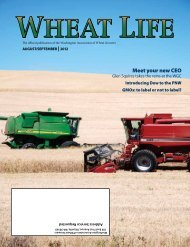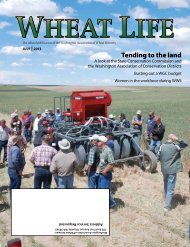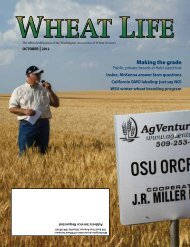Download - Wheat Life
Download - Wheat Life
Download - Wheat Life
You also want an ePaper? Increase the reach of your titles
YUMPU automatically turns print PDFs into web optimized ePapers that Google loves.
WL<br />
WGC REPORTS<br />
WASHINGTON GRAIN COMMISSION<br />
N applications to improve grain<br />
protein content.<br />
In dryland systems, N is most<br />
effective in influencing grain yield<br />
and protein content when it is<br />
absorbed through the root system.<br />
However, some growers have successfully<br />
used foliar applications of<br />
fluid urea or urea ammonium nitrate<br />
to manage grain protein content<br />
in hard wheat. Research shows<br />
this practice is highly dependent on<br />
favorable weather conditions (cool,<br />
moist) after foliar applications are<br />
made.<br />
WSU’s wheat breeders have made<br />
great strides in developing superior<br />
hard wheat varieties for Eastern<br />
Washington’s climatic conditions,<br />
but their efforts can only go so far.<br />
Farmers are key to ensuring the<br />
varieties of hard red winter, hard<br />
red spring and hard white wheat<br />
meet the protein levels which will<br />
reimburse them for the additional<br />
management the crop demands.<br />
Rich Koenig is a soil scientist and<br />
chairman of the Department of Crop<br />
and Soil Science at Washington State<br />
University<br />
State statistic service<br />
changing to handle cuts<br />
By Scott A. Yates<br />
The National Agricultural Statistic Service (NASS) has already announced<br />
that it intends to eliminate an array of commodity-related<br />
program reports, but what could be even a bigger change would see<br />
the agency’s main functions consolidate into nine regional centers.<br />
David Knopf, director<br />
for the Washington Field<br />
Office of NASS, made it<br />
clear the change is still<br />
a proposal, but it has<br />
been reported elsewhere<br />
that a senior executive<br />
team within NASS has<br />
accepted the plan and is<br />
awaiting approval from<br />
the U.S. Department of<br />
Agriculture. The initiative<br />
would streamline the<br />
agency’s 45 field offices<br />
into nine regional offices<br />
while maintaining a token<br />
presence of two employees<br />
in each state. Currently,<br />
Washington State’s field<br />
office has 16 employees.<br />
Under the proposal,<br />
many of the functions<br />
currently performed within Washington would be transferred to a<br />
regional hub based in Sacramento. State and county estimates would<br />
be done from the consolidated location. Part of the task of the two individuals<br />
who would remain behind would be to serve as commodity<br />
organization contacts and to work with the state’s 70, part-time enumerators<br />
who gather information for reports that can’t be conducted on<br />
a regional basis.<br />
Knopf said it’s anticipated the 14 individuals who would not be staying<br />
at the state office, nine of whom are statisticians, would have the<br />
opportunity to transfer to a regional office or receive an early retirement<br />
buy-out, among other possible options. Besides California, the<br />
regional hubs would be located in Pennsylvania, Kentucky, Florida,<br />
Iowa, Missouri, South Dakota, Texas and Colorado. It’s expected each<br />
hub would have a workforce of approximately 45 employees. In creating<br />
the regional offices, NASS senior staff is said to have considered<br />
which states have similar cash receipts, agricultural issues, existing<br />
survey programs as well as the average workload of the current state<br />
staff.<br />
58 WHEAT LIFE JANUARY 2012










